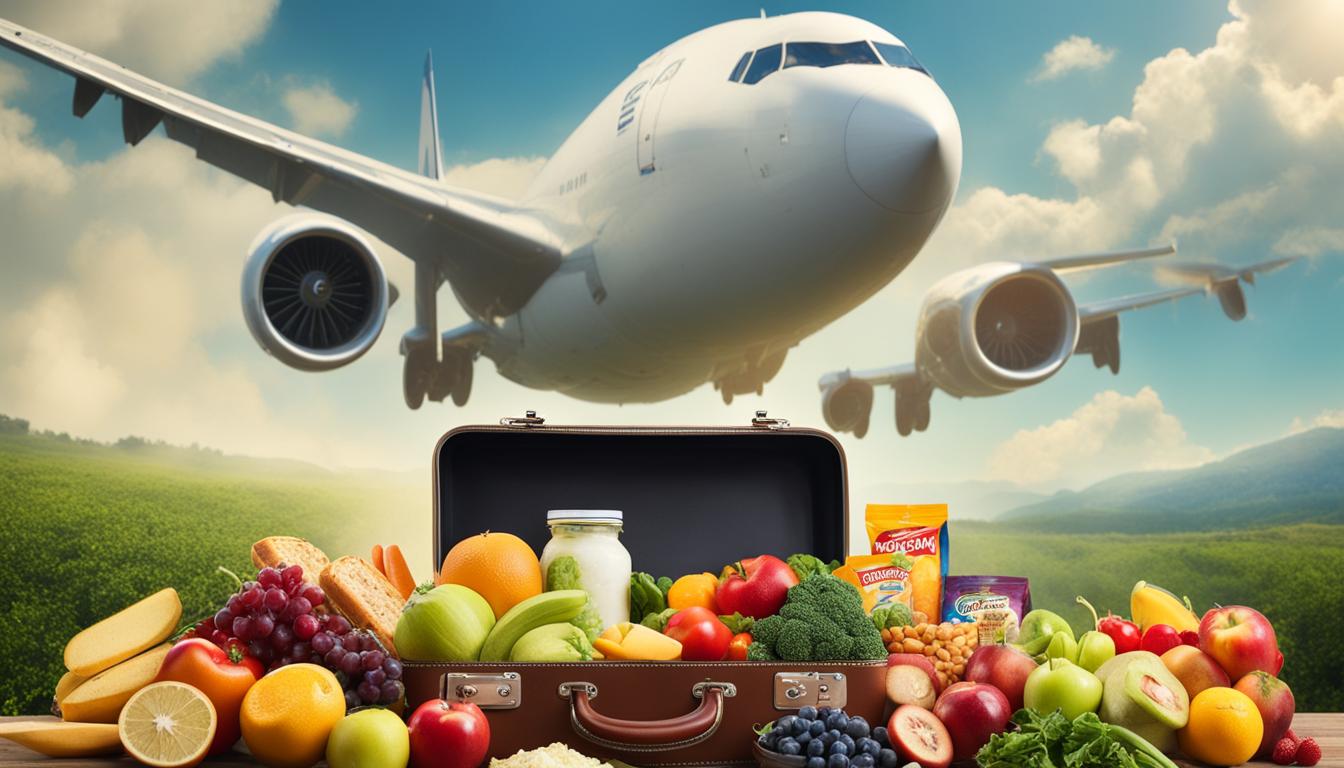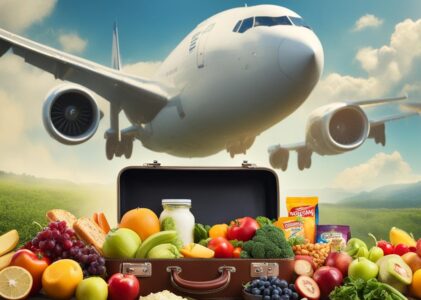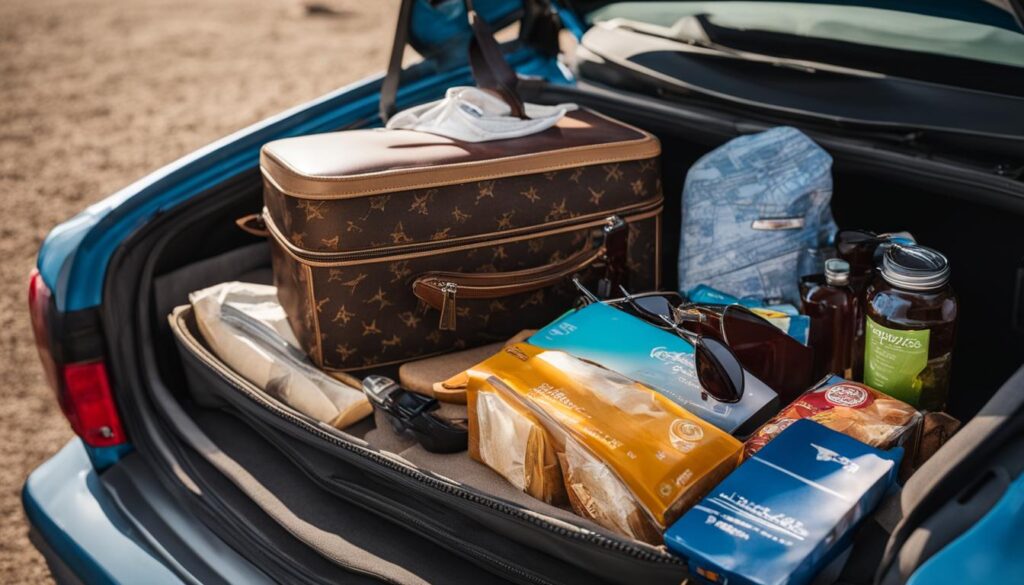When it comes to traveling on an airplane, many people wonder if they can pack food in their suitcase. The good news is that, in general, it is allowed to bring food in your luggage according to the Transportation Security Administration (TSA). However, there are important guidelines and restrictions that you need to be aware of to ensure a smooth travel experience.
Key Takeaways:
- Packing food in your suitcase on an airplane is generally allowed by the TSA.
- Make sure to follow the specific guidelines and restrictions set by the TSA when packing food.
- There are certain food items that are prohibited or restricted, so it’s important to know what not to pack.
- Follow the TSA’s 3-1-1 rule for liquids and gels when packing food in your carry-on luggage.
- When bringing food from your destination, be aware of any customs regulations and restrictions.
TSA Food Guidelines for Packing Food on a Plane
When it comes to packing food in your suitcase on an airplane, it’s important to be aware of the TSA food guidelines and regulations. While it is generally allowed to bring food in your carry-on, there are certain restrictions and considerations to keep in mind.
The TSA follows a 3-1-1 rule for liquids and gels, which also applies to food items. Each passenger is allowed to bring a quart-sized bag of liquids, aerosols, gels, creams, and pastes in their carry-on bag. Each container must be 3.4 ounces (100 milliliters) or less. This rule ensures smooth security screenings and prevents any potential hazards.
Prohibited and Restricted Food Items
While most food items are allowed in your suitcase on an airplane, there are some exceptions. Certain foods may be considered hazardous or pose a safety risk. Some examples of prohibited or restricted food items include:
- Meat and dairy products that are not vacuum-sealed or commercially packaged
- Fruits and vegetables that are not prepackaged or washed
- Homemade or unpackaged food items
- Alcoholic beverages over a certain percentage of alcohol by volume
It’s important to check the TSA website or contact your airline for a comprehensive list of prohibited or restricted food items before packing for your trip. Additionally, some countries may have their own regulations regarding food items, so it’s essential to research and comply with customs regulations at your destination.
| Food Item | Allowed on Plane? |
|---|---|
| Individually packaged snacks | Yes |
| Wrapped sandwiches | Yes |
| Fresh fruits and vegetables | Yes (as long as prepackaged or washed) |
| Unpackaged meats and dairy | No |
By familiarizing yourself with the TSA food guidelines and following any specific airline or customs regulations, you can ensure a smooth and hassle-free travel experience when it comes to packing food in your suitcase.
Tips for Packing Food for Air Travel
When it comes to packing food for air travel, there are a few important tips to keep in mind. Firstly, it’s important to choose foods that are not easily perishable and can withstand the duration of your journey. Opt for items such as granola bars, dried fruits, nuts, and snacks that are individually wrapped and sealed to maintain freshness.
In addition to selecting the right foods, proper packaging is crucial. Make sure to use leak-proof containers or resealable bags to prevent any spills or contamination. It’s also a good idea to pack snacks in portioned sizes, making it easy to access and consume during your flight.
Furthermore, consider the potential restrictions on liquids or gels when packing food. The Transportation Security Administration (TSA) adheres to a 3-1-1 rule, which allows passengers to carry liquids and gels in containers of 3.4 ounces (100 milliliters) or less, placed in a single quart-sized clear bag. This rule applies to both food items and other personal care products.
Table: Examples of Airline Food Packing Rules
| Food Item | Allowed | Restricted |
|---|---|---|
| Fruits and Vegetables |
|
|
| Snacks |
|
|
| Dry Foods |
|
|
Remember, it’s always a good idea to check with your airline’s specific policies and guidelines regarding food items. They may have additional restrictions or requirements that you need to be aware of before packing your food for air travel.
By following these tips and being mindful of the rules, you can ensure a hassle-free journey with your packed food. Whether you’re traveling for business or pleasure, having your favorite snacks on hand can make the flight more enjoyable and convenient.
What Not to Pack in Your Suitcase
While most food items are allowed in your suitcase on an airplane, there are some items that are prohibited or restricted. It’s important to be aware of these items to ensure a smooth and hassle-free travel experience. Here are a few examples of food items that you should avoid packing in your suitcase:
- Fresh fruits and vegetables: These items are generally not allowed due to the risk of spreading pests or diseases.
- Meat and dairy products: These items are often prohibited or restricted due to the potential for spoilage and contamination.
- Liquids and sauces: While small quantities of liquids are allowed under the TSA’s 3-1-1 rule, it’s best to avoid packing large containers of liquids or sauces to prevent spills and hassle at security checkpoints.
- Alcohol: Bringing your own alcohol on a plane is generally not allowed, unless it is in a small container and meets the airline’s specific regulations.
- Certain types of seafood: Some types of seafood, such as live fish or shellfish, may be prohibited or require special permits to transport.
It’s important to note that these are just a few examples, and there may be other specific food items that are prohibited or restricted based on airline or customs regulations. Therefore, it’s always a good idea to check with the airline or refer to the official TSA website for the most up-to-date information on prohibited food items.
By being aware of what not to pack in your suitcase when it comes to food items, you can ensure a smooth and hassle-free travel experience. Remember to always review the guidelines and regulations before your trip to avoid any unexpected issues at security checkpoints or customs.
| Prohibited Food Items | Restricted Food Items |
|---|---|
| Fresh fruits and vegetables | Meat and dairy products |
| Liquids and sauces | Alcohol |
| Certain types of seafood |
Tips for a Smooth Security Screening Process
When traveling with food in your suitcase, it’s important to be prepared for the security screening process to ensure a smooth experience. Here are some tips to help you navigate the TSA security checks:
- Organize your food items: Pack your food in clear, resealable bags or containers to make it easier for security officers to inspect. Separating solid food items from liquids and gels will help streamline the screening process.
- Adhere to the 3-1-1 rule: Remember that liquids, gels, and aerosols in your carry-on must be in containers of 3.4 ounces (100 milliliters) or less, all fitting into a single quart-sized bag. This rule applies to food items such as sauces, dips, and dressings.
- Remove food from your bag: Place your food items in a separate bin during the security screening process. This allows the officers to get a clearer view of the contents and prevents any potential contamination or confusion.
- Be prepared for additional screening: Some food items may require further inspection, especially if they appear suspicious on the x-ray machine. Stay calm and cooperate with the security officers if they need to take a closer look at your food.
By following these tips, you can help ensure a hassle-free security screening process when traveling with food in your suitcase. Remember to stay informed about any specific airport or airline regulations to avoid any unexpected issues.
Table: TSA Food Screening Guidelines
| Food Item | Allowed in Carry-On | Restrictions |
|---|---|---|
| Fruits and Vegetables | Yes | May require additional inspection |
| Meat and Poultry | Yes | Must be properly wrapped or contained |
| Snacks and Dry Foods | Yes | N/A |
| Liquids and Gels | Only within the 3-1-1 rule | Must be in containers of 3.4 ounces or less |
It’s important to note that these guidelines may vary slightly depending on the specific airport or the discretion of the security officers. Always check the latest TSA regulations before your trip to stay informed and avoid any surprises.
Bringing Food from Your Destination
When traveling, one of the joys is experiencing the local cuisine and bringing back food souvenirs from your destination. However, before packing these culinary delights in your suitcase, it’s important to familiarize yourself with the customs regulations for food in both your departure and arrival destinations.
Customs regulations vary from country to country, and some food items may be prohibited or require special permits. To avoid any issues or delays at customs, it’s crucial to do your research beforehand. Check if there are any restrictions on bringing certain types of food, such as fresh produce, dairy products, or meat products.
Additionally, some countries may have restrictions on the quantity of food you can bring, or they might require specific labeling or packaging for certain items. It’s essential to adhere to these regulations to ensure a smooth entry into your destination country.
To find out the specific customs regulations for food in your departure and arrival destinations, you can visit the official website of the customs agency or contact the embassy or consulate of the respective countries. By following these regulations, you can bring back food souvenirs from your travels without any hassle.
Conclusion
In conclusion, yes, you can pack food in your suitcase when traveling on an airplane. However, it’s important to be aware of the guidelines and restrictions in place to ensure a smooth journey. One important rule to remember is the TSA’s 3-1-1 rule for liquids and gels. This means that any liquids or gels you pack, including sauces, dressings, or yogurt, must be in containers of 3.4 ounces or less and all containers must fit into a single quart-sized bag.
When it comes to solid food items like sandwiches, fruits, or snacks, they are generally allowed in your carry-on or checked baggage. However, it’s recommended to pack them in a way that won’t cause any spills or contamination. Using leak-proof containers or wrap and seal them tightly with cling wrap can help prevent any mess.
It’s also important to be mindful of any specific airline or customs regulations, especially if you are traveling internationally. Some countries may have restrictions on bringing certain food items, or they may require special permits for items like fresh produce or meat products. Familiarize yourself with the rules of both your departure and arrival destinations to avoid any issues at customs.
By following these guidelines and being prepared, you can pack food in your suitcase for air travel without any hassle. Whether you’re bringing your own snacks or bringing food souvenirs from your destination, with a little planning, you can enjoy your journey with your favorite food items by your side.
FAQ
Can I pack food in my suitcase on an airplane?
Yes, you can generally pack food in your suitcase when traveling on an airplane. However, there are guidelines and restrictions that you need to be aware of.
What are the TSA food guidelines for packing food on a plane?
The Transportation Security Administration (TSA) has specific guidelines in place for packing food on a plane. It’s important to follow their 3-1-1 rule for liquids and gels.
What are some tips for packing food for air travel?
When packing food for air travel, make sure to use leak-proof containers and pack items that are not easily spoiled. It’s also a good idea to pack non-perishable snacks for longer flights.
What food items are prohibited or restricted in luggage?
While most food items are allowed, there are some items that are prohibited or restricted. Examples include liquids over 3.4 ounces, creamy spreads, and fresh fruits or vegetables.
How can I ensure a smooth security screening process when traveling with food in my suitcase?
To ensure a smooth security screening process, pack food items in clear, resealable bags and place them in an easily accessible location in your suitcase. Remove any metal packaging or containers before going through security.
What should I consider when bringing food from my destination?
When bringing food from your destination, especially if it’s from abroad, familiarize yourself with the customs regulations of both your departure and arrival destinations. Some food items may be prohibited or require special permits.
Can I pack food in my suitcase on an airplane?
In conclusion, it is generally allowed to pack food in your suitcase when traveling on an airplane. However, it’s important to follow the TSA guidelines and any specific airline or customs regulations.




